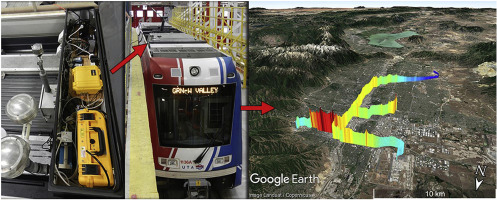当前位置:
X-MOL 学术
›
Atmos. Environ.
›
论文详情
Our official English website, www.x-mol.net, welcomes your
feedback! (Note: you will need to create a separate account there.)
Monitoring of greenhouse gases and pollutants across an urban area using a light-rail public transit platform
Atmospheric Environment ( IF 4.2 ) Pub Date : 2018-08-01 , DOI: 10.1016/j.atmosenv.2018.05.044 Logan E. Mitchell , Erik T. Crosman , Alexander A. Jacques , Benjamin Fasoli , Luke Leclair-Marzolf , John Horel , David R. Bowling , James R. Ehleringer , John C. Lin
Atmospheric Environment ( IF 4.2 ) Pub Date : 2018-08-01 , DOI: 10.1016/j.atmosenv.2018.05.044 Logan E. Mitchell , Erik T. Crosman , Alexander A. Jacques , Benjamin Fasoli , Luke Leclair-Marzolf , John Horel , David R. Bowling , James R. Ehleringer , John C. Lin

|
Abstract Anthropogenic emissions within urban environments are characterized by spatial heterogeneity and temporal variability that present challenges for measuring urban greenhouse gases and air pollutants. To address these challenges, we mounted instruments on public transit light-rail train cars that traverse the metropolitan Salt Lake Valley (SLV) in Utah, USA to observe the temporal and spatial variability of atmospheric species including carbon dioxide (CO2), methane (CH4), ozone (O3), fine particulate matter (PM2.5), and nitrogen dioxide (NO2). Utilizing electrified light-rail public transit as an observational platform enables real-time measurements with low operating costs while avoiding self-contamination from vehicle exhaust. We examine temporal averages and case studies of each species that reveal gradients, intermittent point sources, seasonal and diel changes, and complex relationships resulting from emissions, atmospheric chemistry, and meteorological conditions. CO2 and NO2 are related through the combustion of fossil fuel and we observed a broad spatial gradient across the city as well distinct plumes at traffic intersections and, for NO2, a large plume adjacent to a locomotive rail yard. Distributions of O3 were strongly correlated with NO2 due to atmospheric photochemical and titration processes. Episodes of high PM2.5 had distinct spatial patterns depending on meteorological conditions during wintertime persistent cold-air pool episodes. The spatial pattern of CH4 was characterized by distinct plumes associated with industrial and commercial facilities, some of which followed temporal patterns indicative of daytime working hours; other plumes were persistent throughout the whole day, suggestive of leak-related fugitive emissions. The ongoing multi-year record of spatial and temporal air quality observations provides a valuable data set for future air quality exposure studies. Our results suggest pollution and greenhouse gas emission monitoring and exposure assessment could be greatly enhanced by deploying instruments on public transit systems in urban centers worldwide.
中文翻译:

使用轻轨公共交通平台监测整个城区的温室气体和污染物
摘要 城市环境中的人为排放具有空间异质性和时间可变性,这对测量城市温室气体和空气污染物提出了挑战。为了应对这些挑战,我们在穿越美国犹他州盐湖谷 (SLV) 的公共交通轻轨列车车厢上安装了仪器,以观察包括二氧化碳 (CO2)、甲烷 (CH4 )、臭氧 (O3)、细颗粒物 (PM2.5) 和二氧化氮 (NO2)。利用电气化轻轨公共交通作为观察平台,可以以较低的运营成本进行实时测量,同时避免车辆尾气造成的自我污染。我们检查了每个物种的时间平均值和案例研究,这些研究揭示了梯度、间歇性点源、季节性和昼夜变化,以及排放、大气化学和气象条件造成的复杂关系。CO2 和 NO2 与化石燃料的燃烧有关,我们观察到整个城市的广泛空间梯度以及交通路口的明显烟羽,对于 NO2,还有靠近机车铁路站场的大烟羽。由于大气光化学和滴定过程,O3 的分布与 NO2 密切相关。在冬季持续性冷空气池事件期间,高 PM2.5 事件具有不同的空间模式,具体取决于气象条件。CH4 的空间格局以与工业和商业设施相关的独特羽流为特征,其中一些遵循指示白天工作时间的时间模式;其他羽流一整天都持续存在,表明存在与泄漏相关的无组织排放。持续多年的空间和时间空气质量观测记录为未来的空气质量暴露研究提供了宝贵的数据集。我们的结果表明,通过在全球城市中心的公共交通系统上部署仪器,可以大大加强污染和温室气体排放监测和暴露评估。
更新日期:2018-08-01
中文翻译:

使用轻轨公共交通平台监测整个城区的温室气体和污染物
摘要 城市环境中的人为排放具有空间异质性和时间可变性,这对测量城市温室气体和空气污染物提出了挑战。为了应对这些挑战,我们在穿越美国犹他州盐湖谷 (SLV) 的公共交通轻轨列车车厢上安装了仪器,以观察包括二氧化碳 (CO2)、甲烷 (CH4 )、臭氧 (O3)、细颗粒物 (PM2.5) 和二氧化氮 (NO2)。利用电气化轻轨公共交通作为观察平台,可以以较低的运营成本进行实时测量,同时避免车辆尾气造成的自我污染。我们检查了每个物种的时间平均值和案例研究,这些研究揭示了梯度、间歇性点源、季节性和昼夜变化,以及排放、大气化学和气象条件造成的复杂关系。CO2 和 NO2 与化石燃料的燃烧有关,我们观察到整个城市的广泛空间梯度以及交通路口的明显烟羽,对于 NO2,还有靠近机车铁路站场的大烟羽。由于大气光化学和滴定过程,O3 的分布与 NO2 密切相关。在冬季持续性冷空气池事件期间,高 PM2.5 事件具有不同的空间模式,具体取决于气象条件。CH4 的空间格局以与工业和商业设施相关的独特羽流为特征,其中一些遵循指示白天工作时间的时间模式;其他羽流一整天都持续存在,表明存在与泄漏相关的无组织排放。持续多年的空间和时间空气质量观测记录为未来的空气质量暴露研究提供了宝贵的数据集。我们的结果表明,通过在全球城市中心的公共交通系统上部署仪器,可以大大加强污染和温室气体排放监测和暴露评估。









































 京公网安备 11010802027423号
京公网安备 11010802027423号